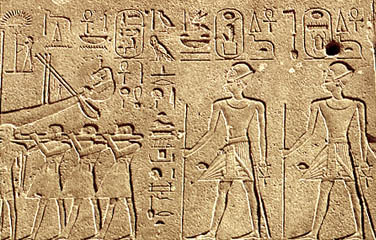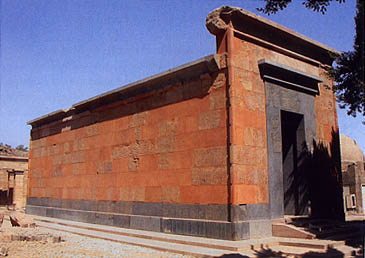
The Beautiful Feast of Opet
Hab Nefer en Opet

Hatshepsut and Thutmose III following the sacred barque in the Opet
procession; in the Chapelle Rouge, from Hatshepsut: From Queen to Pharaoh
The Beautiful Feast of the Residence, Hab Nefer en Opet or simply the Opet Festival, refers to the 'residence' of the god Amun in Karnak, his state temple in Thebes. The Opet Festival was celebrated annually in Thebes during the second month of Akhet, or the season of Inundation. Today it would fall in late August or early September. The first records we have of the Opet Festival date from the beginning of the Eighteenth Dynasty; some scholars believe the festival was begun by Hatshepsut. After being crowned as pharaoh, she expanded upon the temple of Karnak and built a shrine, the recently reconstructed Chapelle Rouge ("Red Chapel"), as a way station for the Opet festivities.
Together with the Feast of the Valley, the Feast of Opet was the most important holiday in the religious calendar at Thebes. A celebration of renewal, it lasted more than a week--later in Egyptian history the celebration stretched to well over two weeks long. A prominent feature of the Opet Festival was the procession of a statue of Amun through the city. Throughout most of the year, a golden statue (often called an oracle statue) of Amun-Ra resided deep within the inner sanctum of the state temple at Karnak. Unlike modern religious shrines where anyone can enter to worship, Amun's temple at Karnak was considered his actual home, accessible only to priests, royal officials and the pharaoh himself. During festivals, however, priests placed Amun's statue incarnation into a portable shrine mounted on a model boat called a barque. A group of priests, all shaven-headed, carried the barque on poles into the city in a grand parade attended by the cheering populace of Thebes. According to some temple records, priests also distributed offerings of bread and beer among the attendants. The spectacle of singing and celebration must have been similar to one still seen today in Latin American countries and Mexico, where villagers parade statues of local saints or the Blessed Virgin accompanied by adorers bearing flowers and offerings. In fact, the Opet procession lives on today in a different form, as modern residents of Thebes celebrate a local Muslim saint's feast day--complete with a model boat.
In its original form, the Opet procession allowed common citizens a chance to address Amun directly by bringing their petitions or questions before the oracle. Stories recorded in papyrus tell of a variety of revelations revealed by the oracle--whether the statue answered questions with the help of priests, or through divine revelation, is up to the modern observer to decide.
At various points in the procession were barque stations, such as the Chapelle Rouge, at which the travelling shrine would stop. These way stations not only served as permanent markers of the land portion of the parade route, but also gave the priests carrying the sacred barque a chance to rest. But while one part of the Opet festivities took place on foot, the other part took place over water. The trio of Amun, Mut and Khonsu were loaded onto a festival barge and towed along the Nile as partygoers lined the banks to cheer its passing. The festival finally ended when the divine statues were returned to their respective temples.

The reconstructed Red Chapel, "Place of the Heart of Amun"--from Hatshepsut: From Queen to Pharaoh
Amun's procession in the Opet Festival held a cosmic meaning. It took the oracle statue from the state temple in Karnak to another temple two miles south in Luxor, which was considered Amun's southern residence. Along the way Amun was joined by oracles of his consort Mut and their son Khonsu. Their journey was symbolic, representing Amun's yearly rejuvenation with the seasons. In the Luxor temple, the pharaoh officiated personally in ceremonies that brought about not only Amun's renewal, but also his own divine legitimacy as king. These rituals ensured that order and divine rule--the sacred principle of Ma'at--would continue.
The Opet ceremonies doubtless took on an even greater significance in Tutankhamun's time. During the Amarna period, citizens of Egypt who clung to their traditional beliefs must have felt that chaos loomed without religious observances like the Hab Nefer en Opet to maintain cosmic order. Most likely, the old festivals were reinstated in Year 3 of Tutankhamun's rule when his court returned to Thebes from Amarna. The first Beautiful Feast of Opet that he officiated was probably charged with a sense of both trepidation and relief from his subjects. What he must have felt as he first observed the rituals in front of Amun's oracle, we will never know.
References:
Brier, Bob. Ancient Egyptian Magic. New York: Quill Press, 1980.
Gore, Rick. "Ramses the Great." National Geographic April 1991: 2-31.
Roerig, Catharine H. et al. Hatshepsut: From Queen to Pharaoh. New York: Metropolitan Museum of Art, 2005.
A Good Link on the Beautiful Feast of Opet:
http://www.touregypt.net/featurestories/festival.htm
Back to Temple Main Page